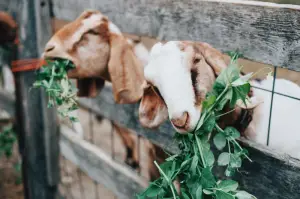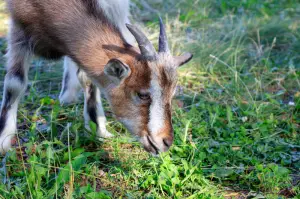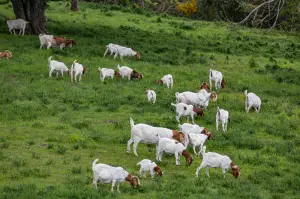Using Goats To Clear Land
More people are using goats to clear land than ever before – and this isn’t just limited to homesteaders. Goats are used everywhere to clear government-owned land, parks, and lots owned by large businesses, and they are even used in state and federal parks to clear invasive plants and to help mitigate the spread of wildfires. No other livestock comes close to the humble goat in terms of clearing brush, and if you are interested in them for this reason, you’ll want to learn all you can about these natural lawnmowers.
How can you use goats to clear land? Unlike other livestock, goats are browsers and not grazers. This means that they will happily eat the tall weeds, brush, leaves, and even tree bark that sheep and cattle will ignore. The amount of time it will take a herd of goats to clear land will vary greatly, but on average, you may expect ten goats to clear an acre of land in about a month.
If you’re interested in ditching the lawnmower and using goats to clear your land, you will want to learn more about the process, including what to look for in a brush goat and what they can and can’t eat. Read on for all of this information and more.
Using Goats To Clear Land: Brush They Can And Cannot Eat 
Goats have a reputation for eating anything and everything, but the reality is that they are more selective than many feel led to believe. Part of this reputation may have been earned by the fact that goats can eat a number of plants that humans, and even some other livestock, can’t or won’t touch.
Goats will happily eat blackberry brambles and other thorned plants, spurge, thistles, and even poison ivy. Goats eat a wide variety of woody shrubs, tree leaves, weeds, and even tree bark. Goats have unique nutrient requirements that can be met by eating a variety of different plant matter as opposed to strictly grasses.
This does not mean that goats can eat every kind of plant. Some plants are toxic to goats, and they should be removed from a pasture before introducing your animals. These plants include but are not limited to: oak leaves, oleander, rhododendron, yew, azaleas, bracken fern, buttercup, iris, and leaves from various stone fruit trees.
How Quickly Can Goats Clear Land?
The amount of time it takes a herd of goats to clear an acre of land will have several variables, including the type of brush and vegetation that needs to be cleared, the breeds of goats used, and how quickly the specific weeds take to re-grow. A very rough estimate might be that it can take around ten goats to clear an acre of land in a month.
What we do know is that in order to use goats to clear brush, you must have more goats than your land can sustain. We know that given average conditions, you can expect one acre of land to sustain 6-8 goats. This means that in order to clear this acre of land in average conditions, you will need more goats than this. If you would like to clear an acre of land in very little time, you may choose to “rent” as many as 20 goats for that acre.
Whether you are raising goats to maintain your homestead or you are hiring a goat farmer to clear a large property, you can benefit from using rotational grazing. Rotational grazing involves breaking up your land into smaller pastures or paddocks so that your goats only have access to one piece of land at a time.
You should aim for 4-6 different mini-pastures, with the goats staying on each for a total of one week before moving on to the next. Not only does this limit the goats to eating what is in front of them, but it is also a remarkable resource for controlling parasites – eggs that are eliminated from the goat take approximately 4-6 weeks to hatch, and if no host is available, will die shortly thereafter, leaving the field with relatively few parasites once the goats circle back.
Best Goat Breeds For Clearing Land
Any breed of goat can be used for clearing brush, and in fact, many goat farmers who rent their animals out for land clearing will use mixed breeds. Mixed breeds are very hardy, often have increased parasite and disease resistance, and are much less expensive to purchase when starting up than purebred goats. Nevertheless, if you would like to purchase a specific breed for this purpose, the following are notable for their brush-clearing abilities:
- Kikos – the Kiko is a meat breed originating from the harsh landscape of New Zealand. They were developed by crossing a dairy breed with the feral goats of the area, creating a hardy, scrappy animal that is an efficient forager, has remarkable resistance to parasites and foot rot, and is a good mother with little kidding intervention required. As an added bonus, Kikos are known to be rather docile and easy to handle.
- Spanish goats – another name for the Spanish goat is “brush goat.” These goats originated from the animals brought to Texas from Spain in the 1500s. They were largely left alone and allowed to develop through natural selection, leading to a type of goat that is tolerant of harsh landscapes, excellent at foraging (and surviving, in general), and very hardy.
- Alpines – the Alpine is a popular dairy breed. They are known to be eager eaters, often climbing into trees to eat their preferred leaves. This attribute, combined with their larger size, allows the Alpine to reach and eat brush that is too tall for goats of other breeds to get to. They are also easy-going and make excellent herd leaders.
In addition to breed, here are a few other factors to look for in a brush goat:
- Size – if, like most of us, you have a variety of brush as opposed to one type of plant in your pasture, you might consider getting several different kinds of goats. The smaller ones will more easily eat the lower brush, while the larger ones will be able to reach the tallest of the weeds.
- Sex – most goat farmers would recommend limiting or omitting the bucks in a herd used for clearing brush. Bucks can be aggressive, they have a significant odor during breeding season, and they will be too distracted by the does to effectively cut down on the brush. Wethers (castrated males) and does are usually the sex of choice when choosing a herd for clearing brush. Keep in mind that if you have a lot of brambles or low, thick brush, the vegetation can cause injury to the udders of the doe – with this kind of forage, you may choose to stick with wethers.
- Dual-purpose – goats are often used for more than one purpose. Your choice of brush goat may depend on whether you are using goats for another operation or not. If you are running a dairy operation, you will want to stick with brush goats who will provide ample milk. Stick with a stockier, traditional “meat” breed if you are planning to also use your brush goats for meat.
Before doing too much research into goat breeds, it would be a good idea to see what is available in your area. You may not have access to any Kiko, Spanish, or Alpine goats. Chances are, you will have access to some mixed-breed goats, though.
You can also call local breeders or goat farmers to ask more questions – ask how efficient they are at clearing the land of the specific weeds that you are hoping to eradicate, ask how they do on the terrain or landscape that you have on your land and ask about their specific care requirements.
You have the ability to do ample research about goats online, but nothing beats the experience of a goat farmer in your specific region.
Clearing Land With Goats: Start Small 
It can be a challenge to recommend a specific number of goats to clear land, as there are so many factors that go into that equation.
You may decide you would like a mixed breed of goat, but you’re unsure how the ones available in your area will perform on your land.
You may have mature, older growth that will take a herd a longer time to work through than a fresh field. Or, you may desire a simple “clean-up,” which will take less time than a complete clearing. Regardless of your needs, if you are unsure about how many goats you will require, it would be a good idea to start small.
Buy 4-5 goats and pen them into a ½ acre parcel – watch them closely over the next couple of weeks to see what they eat, what they ignore, and how long it is taking to turn that neglected pasture into barren land. Unless you are in a hurry, you should take the time to investigate how your goats perform on your specific land – you can always increase the number of goats as you go.
You can learn more about goats and other homestead animals in my latest articles here!

